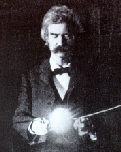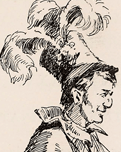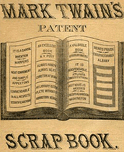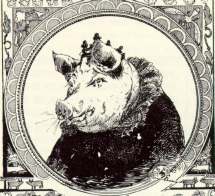 Connecticut Yankee was shorter than
a subscription book was supposed to be, so its design took
full advantage of Beard's pictures (and a generous amount of
white space) to stretch its length. Although he had to work
quickly to keep the book on deadline (according to Beard, the
illustrations were produced in about 70 days), Beard's work
displays a lot of wit, elegance and attention to both visual
and thematic detail. One of the striking characteristics is
the way the drawings feature many well-known 19th-century
faces on the book's 6th-century characters. Beard's usual
practice as an illustrator was to work from both live models
and "a large collection of photographs" of contemporary
celebrities and "prominent people." All MT's readers would
have recognized the original of the sow at left, for example,
though not all would have been amused. Clicking on her will
take you to a gallery displaying
Beard's drawings of famous people as characters in the
novel, and the originals they are based on.
Connecticut Yankee was shorter than
a subscription book was supposed to be, so its design took
full advantage of Beard's pictures (and a generous amount of
white space) to stretch its length. Although he had to work
quickly to keep the book on deadline (according to Beard, the
illustrations were produced in about 70 days), Beard's work
displays a lot of wit, elegance and attention to both visual
and thematic detail. One of the striking characteristics is
the way the drawings feature many well-known 19th-century
faces on the book's 6th-century characters. Beard's usual
practice as an illustrator was to work from both live models
and "a large collection of photographs" of contemporary
celebrities and "prominent people." All MT's readers would
have recognized the original of the sow at left, for example,
though not all would have been amused. Clicking on her will
take you to a gallery displaying
Beard's drawings of famous people as characters in the
novel, and the originals they are based on.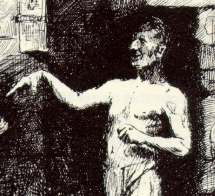 MT's original
intention was to supervise Beard's work closely.
Intending as always for the book to be as popular as
possible, he was anxious about the points at which his story
would rub up against contemporary beliefs, and as with
Kemble's work on Huck Finn, he expected the
illustrations to tone the book down: "I have aimed to put all
the crudeness and vulgarity in the book," he wrote Beard,
"and I depend on you for the refinement and scintillating
humor for which you are so famous." But he liked the first
samples Beard submitted so much that he decided to leave the
artist alone to "obey his own inspiration" -- "I want
his genius to be wholly unhampered." MT was delighted with
the results. You can see a gallery of
MT's favorite pictures by clicking here. After the novel
was published, MT wrote an acquaintance that "to my mind the
illustrations are better than the book -- which is a good
deal for me to say, I reckon."
MT's original
intention was to supervise Beard's work closely.
Intending as always for the book to be as popular as
possible, he was anxious about the points at which his story
would rub up against contemporary beliefs, and as with
Kemble's work on Huck Finn, he expected the
illustrations to tone the book down: "I have aimed to put all
the crudeness and vulgarity in the book," he wrote Beard,
"and I depend on you for the refinement and scintillating
humor for which you are so famous." But he liked the first
samples Beard submitted so much that he decided to leave the
artist alone to "obey his own inspiration" -- "I want
his genius to be wholly unhampered." MT was delighted with
the results. You can see a gallery of
MT's favorite pictures by clicking here. After the novel
was published, MT wrote an acquaintance that "to my mind the
illustrations are better than the book -- which is a good
deal for me to say, I reckon."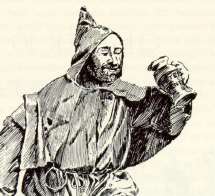 One of the themes MT was
most anxious about was the novel's aggressive attack on
religion: "an established church," Hank writes, "is an
established slave pen." Although Hall told MT that "it was
the Catholic Church that would principally attack [the
novel], and they were not book buyers anyway," it was MT's
design to downplay the book's anti-religious sentiments, to
avoid, for example, including "any religious matter in the
Prospectus" that his book agents would show prospective
customers (see Sales
Prospectus). Beard, however, was a member of the Society
of Friends (the Quakers), and overtly hostile to the
institutionalized Christianity. Many of his drawings rely on
familiar American anti-Catholic stereotypes, as you can see
by clicking on the cleric at
left.
One of the themes MT was
most anxious about was the novel's aggressive attack on
religion: "an established church," Hank writes, "is an
established slave pen." Although Hall told MT that "it was
the Catholic Church that would principally attack [the
novel], and they were not book buyers anyway," it was MT's
design to downplay the book's anti-religious sentiments, to
avoid, for example, including "any religious matter in the
Prospectus" that his book agents would show prospective
customers (see Sales
Prospectus). Beard, however, was a member of the Society
of Friends (the Quakers), and overtly hostile to the
institutionalized Christianity. Many of his drawings rely on
familiar American anti-Catholic stereotypes, as you can see
by clicking on the cleric at
left.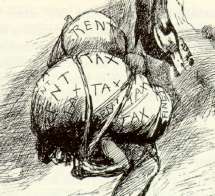
Beard was also a staunch supporter of the "single-tax" political and economic program of contemporary reformer Henry George. His drawings not only enthusiastically reflect the novel's satire on various forms of aristocratic privilege; they also use MT's text as the occasion for giving visual expression to many of the ideas Beard found in George's book, Progress and Property. Click on the burdens at left for some examples of Beard's most explicitly political cartoons.
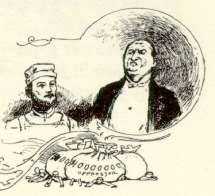 The artists whose
pictures appeared on every second or third page inevitably
shaped the way contemporary readers "saw" and understood the
first editions of MT's texts. Uncharacteristically, MT was
entirely pleased with Beard's work: "What luck it was to find
you!" he told Beard; "There are a hundred artists who could
illustrate any other book of mine, but there was only one who
could illustrate this one." Yet Beard took large liberties in
his drawings. Many of them don't illustrate anything that
appears in the text, but instead extrapolate from MT's words
various ideas that have to be considered Beard's own thematic
contributions to Connecticut Yankee. Although MT gives
Hank the nickname "Sir Boss," for example, Beard's drawings
often equate the injustices of medieval feudalism with the
patterns of late-nineteenth-century American capitalism. For
some examples of Beard's most
"un-authorized" illustrations, click on the robber baron
at left.
The artists whose
pictures appeared on every second or third page inevitably
shaped the way contemporary readers "saw" and understood the
first editions of MT's texts. Uncharacteristically, MT was
entirely pleased with Beard's work: "What luck it was to find
you!" he told Beard; "There are a hundred artists who could
illustrate any other book of mine, but there was only one who
could illustrate this one." Yet Beard took large liberties in
his drawings. Many of them don't illustrate anything that
appears in the text, but instead extrapolate from MT's words
various ideas that have to be considered Beard's own thematic
contributions to Connecticut Yankee. Although MT gives
Hank the nickname "Sir Boss," for example, Beard's drawings
often equate the injustices of medieval feudalism with the
patterns of late-nineteenth-century American capitalism. For
some examples of Beard's most
"un-authorized" illustrations, click on the robber baron
at left.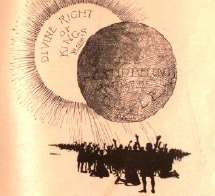 Because MT wanted Connecticut Yankee
to appear in time for the Christmas trade, the sales
prospectus had to be prepared before Beard had finished many
illustrations. Thus the passages from the novel included in
the prospectus are unillustrated. But MT approved Hall's
suggestion to include a 16-page
"signature" of illustrations at the end of the
prospectus. Hall promised MT the sampling did not include
pictures of "anything that would apply directly to the church
or that is strongly political, but whatever makes fun of
royalty and nobility . . . we have put in, as that will suit
the American public well." Hall himself, as "a help to agents
in selling the book," wrote interpretive captions for each
illustration, describing "whatever the picture is intended to
represent." To see what pictures were selected, and how they
were explained to MT's audience, click on the eclipse at
left.
Because MT wanted Connecticut Yankee
to appear in time for the Christmas trade, the sales
prospectus had to be prepared before Beard had finished many
illustrations. Thus the passages from the novel included in
the prospectus are unillustrated. But MT approved Hall's
suggestion to include a 16-page
"signature" of illustrations at the end of the
prospectus. Hall promised MT the sampling did not include
pictures of "anything that would apply directly to the church
or that is strongly political, but whatever makes fun of
royalty and nobility . . . we have put in, as that will suit
the American public well." Hall himself, as "a help to agents
in selling the book," wrote interpretive captions for each
illustration, describing "whatever the picture is intended to
represent." To see what pictures were selected, and how they
were explained to MT's audience, click on the eclipse at
left.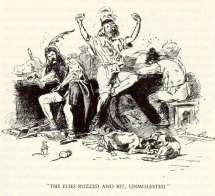 Dan Beard
included himself at the Round Table: the figure in the middle
at left is a self-portrait. He and MT wound up becoming
friends, and MT employed him to illustrate a number of other
texts, including The American Claimant, The Million
Dollar Banknote, Tom Sawyer, Abroad and
Following the Equator. Beard himself claimed, however,
that most publishers and editors were reluctant to hire him
after his critiques of Catholicism and capitalism appeared in
Connecticut Yankee. According to him, "the influence
of vested interests" produced what he called a "boycott" --
what we would call a blacklisting -- "for about ten years."
Despite the revelry on display in his self-portrait, Beard
also became the organizer of the American Boy Scouts, and
served as National Scout Commissioner from 1910 until his
death in 1941.
Dan Beard
included himself at the Round Table: the figure in the middle
at left is a self-portrait. He and MT wound up becoming
friends, and MT employed him to illustrate a number of other
texts, including The American Claimant, The Million
Dollar Banknote, Tom Sawyer, Abroad and
Following the Equator. Beard himself claimed, however,
that most publishers and editors were reluctant to hire him
after his critiques of Catholicism and capitalism appeared in
Connecticut Yankee. According to him, "the influence
of vested interests" produced what he called a "boycott" --
what we would call a blacklisting -- "for about ten years."
Despite the revelry on display in his self-portrait, Beard
also became the organizer of the American Boy Scouts, and
served as National Scout Commissioner from 1910 until his
death in 1941.